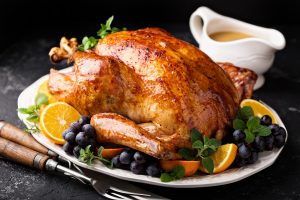 By Angela Treadaway
By Angela Treadaway
As families gather for Thanksgiving, it is also especially important not to forget food safety basics when preparing the holiday meal. Whether the Thanksgiving meal centers around a turkey, ham, roast, or some other dish cooks should make sure that foodborne illness is not an invited guest. By following four basic food safety practices everyone can reduce the risk of foodborne illness. Keep hands and all food preparation surfaces clean, don’t cross-contaminate foodborne bacteria from one food to another, cook to proper temperatures, and refrigerate perishable foods quickly after eating. These tips are part of good food safety practices we should follow all the time but especially for the holidays because all those who may come in and out of your kitchen and or set at your dining table to eat. Whether you know it or not you will probably be serving family with compromised immune systems that could get sick easily. To help reduce foodborne illness chances you should:
Store the turkey….Avoid cross-contamination – thaw safely
Whether you purchase a fresh or frozen turkey is a matter of personal preference. Buy a fresh turkey no more than two days ahead of the big meal and make sure you have adequate storage space in the refrigerator. If a frozen turkey is the choice, you can safely defrost it in the refrigerator, allowing 24 hours for every 5 pounds. Keep in mind a 20lb turkey is not going to defrost overnight. Check that the original bag is not broken, to prevent raw juices from coming in contact with other foods. Also, the turkey can be thawed under cold running water not more than 70 degrees for several hours. Once thawed you want to cook immediately. Never, Never defrost food on the kitchen counter.
Safe cooking
For safety and doneness, the internal temperature of the turkey must reach 165° F in the thigh. Set the oven temperature to 325° F. Use a meat thermometer to be sure the correct internal temperature is reached and to prevent overcooking. A meat thermometer should be used even in turkeys that have “pop-up” temperature indicators to ensure a safe temperature of 165° F. Please do not cook in an oven over night on a low temperature this could be inviting Salmonella
To stuff or not to stuff
The safest way to cook the stuffing is separate from the turkey. But whether the stuffing is cooked inside or outside of the turkey, it must reach an internal temperature of 16F. If the turkey is stuffed, mix ingredients just prior to filling the cavity. Stuff loosely to help ensure safe, even cooking. Both the stuffing and the turkey should reach 165°
APPROXIMATE COOKING TIMES
| Size of Turkey | Cooking Time | Size of Turkey | Cooking Time |
| Unstuffed | Stuffed | ||
| 8 to 12 pounds | 2 ¾ to 3 hours | 8 to 12 pounds | 3 to 3 ½ hours |
| 12 to 14 pounds | 3 to 3¾ hours | 12 to 14 pounds | 3 ½ to 4 hours |
| 14 to 18 pounds | 3 ¾ to 4 ¼ hours | 14 to 18 pounds | 4 to 4 ¼ hours |
| 18 to 20 pounds | 4 ¼ to 4 ½ hours | 18 to 20 pounds | 4 ¼ to 4 ¾ hours |
| 20 to 24 pounds | 4 ½ to 5 hours | 20 to 24 pounds | 4 ¾ to 5 ¼ hours |
Safe handling of leftovers
Cut leftover turkey into small pieces, or slice. Refrigerate stuffing and turkey separately in shallow containers within 2 hours of cooking. Use leftover turkey and stuffing within 3 to 4 days, and gravy within 1 to 2 days. Gravy should be reheated to a boil and other leftovers heated thoroughly as well.
Be Safe and have a Happy Thanksgiving and Merry Christmas with your family and friends!
For more information
Food safety information is available on the web at any state Extension Website like ours www.aces.edu or on our facebook page @ Alabama Cooperative Extension Food Safety & Quality. Angela Treadaway who is a Regional Extension Agent in Food Safety and Quality and who prepared this article can also be contacted at 205-410-3696














